Dark Energy
Dark energy is a mysterious form of energy that makes up about 68% of the universe. It is believed to be responsible for the accelerating expansion of the universe. The nature of dark energy is not well understood, and it is one of the greatest unsolved mysteries in physics.
Study Guide:
- What is Dark Energy?
Dark energy is a hypothetical form of energy that is believed to permeate all of space and is responsible for the observed acceleration of the expansion of the universe. - How was Dark Energy Discovered?
The existence of dark energy was first inferred from observations of distant supernovae in the late 1990s. These observations indicated that the universe's expansion is accelerating, rather than slowing down as previously thought. - What is the Role of Dark Energy in the Universe?
Dark energy is thought to be the dominant component of the universe, causing the expansion of space to accelerate. This has profound implications for the ultimate fate of the universe. - What are the Theories about Dark Energy?
There are several theories about the nature of dark energy, including the cosmological constant, which is a constant energy density that fills space homogeneously. - Current Research and Future Studies:
Scientists are actively researching dark energy using a variety of astronomical observations, such as the study of supernovae, galaxy clusters, and the cosmic microwave background. Future studies aim to better understand the nature of dark energy and its implications for the fate of the universe.
◂Science Worksheets and Study Guides Sixth Grade. Studying and exploring space
Study Guide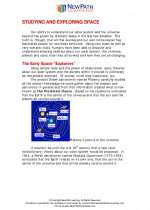 Studying and exploring space
Studying and exploring space  Worksheet/Answer key
Worksheet/Answer key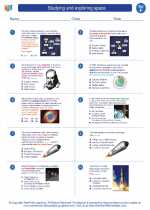 Studying and exploring space
Studying and exploring space  Worksheet/Answer key
Worksheet/Answer key Studying and exploring space
Studying and exploring space  Worksheet/Answer key
Worksheet/Answer key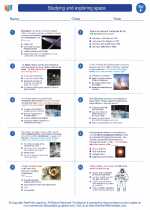 Studying and exploring space
Studying and exploring space  Vocabulary/Answer key
Vocabulary/Answer key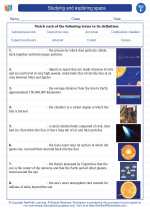 Studying and exploring space
Studying and exploring space  Vocabulary/Answer key
Vocabulary/Answer key Studying and exploring space
Studying and exploring space  Vocabulary/Answer key
Vocabulary/Answer key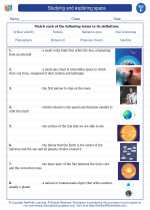 Studying and exploring space
Studying and exploring space  Vocabulary/Answer key
Vocabulary/Answer key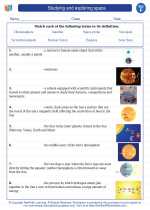 Studying and exploring space
Studying and exploring space 

 Worksheet/Answer key
Worksheet/Answer key
 Worksheet/Answer key
Worksheet/Answer key
 Worksheet/Answer key
Worksheet/Answer key
 Vocabulary/Answer key
Vocabulary/Answer key
 Vocabulary/Answer key
Vocabulary/Answer key
 Vocabulary/Answer key
Vocabulary/Answer key
 Vocabulary/Answer key
Vocabulary/Answer key

The resources above cover the following skills:
EARTH AND SPACE SCIENCE
Earth’s Place in the Universe
Create and manipulate models (e.g., physical, graphical, conceptual) to explain the occurrences of day/night cycles, length of year, seasons, tides, eclipses, and lunar phases based on patterns of the observed motions of celestial bodies.
Construct models and use simulations (e.g., diagrams of the relationship between Earth and man-made satellites, rocket launch, International Space Station, elliptical orbits, black holes, life cycles of stars, orbital periods of objects within the solar system, astronomical units and light years) to explain the role of gravity in affecting the motions of celestial bodies (e.g., planets, moons, comets, asteroids, meteors) within galaxies and the solar system.
Develop and use models to determine scale properties of objects in the solar system (e.g., scale model representing sizes and distances of the sun, Earth, moon system based on a one-meter diameter sun).